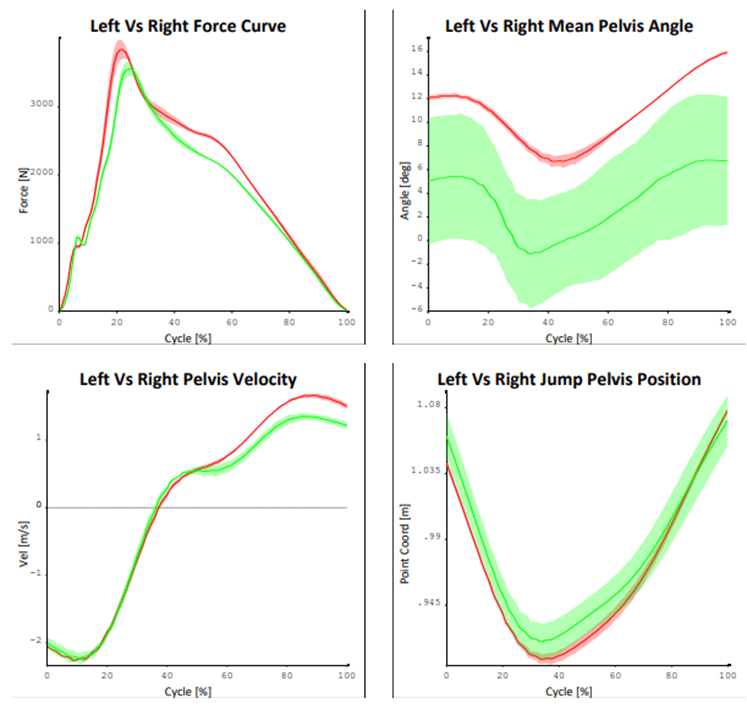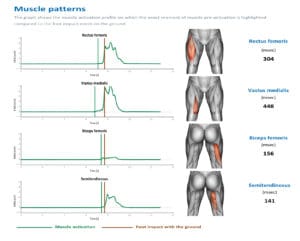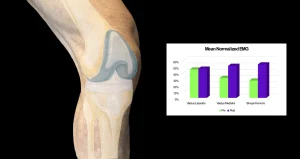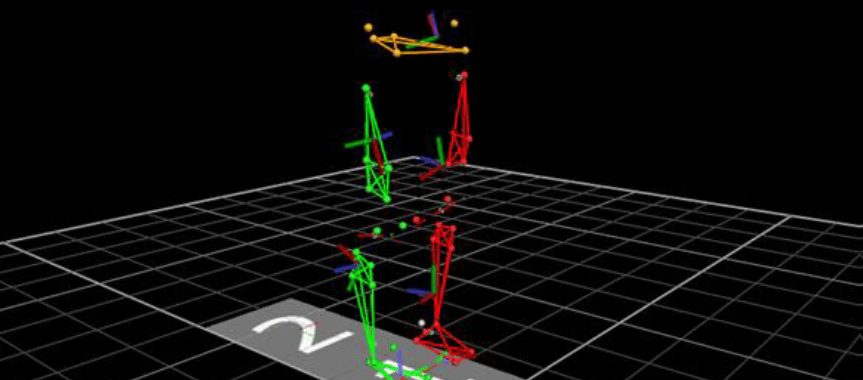Drop Jump Test for ACL Recovery: The 30cm Difference
Article Summary: This study revealed greater limb asymmetry in an anterior cruciate ligament repair (ACLR) athlete while performing a single-leg drop jump test for ACL recovery at 30 cm heights, emphasizing the potential value of proper drop heights for Return to Play assessments (RTP). Differences in Reactive Strength Ratio (RSR), jump height, and pelvis kinematics suggest impaired reactive strength and proprioception on the ACLR side. These findings underscore the importance of comprehensive and ongoing monitoring of limb function following ACL reconstruction. Pelvis kinematics emerged as a promising metric for evaluating asymmetry, offering a simpler and more accessible alternative to full marker-based motion capture. However, further validation involving larger sample sizes and higher drop heights should occur before incorporating pelvis kinematics into standard RTP protocols. Future research should investigate the feasibility of utilizing pelvis kinematics in conjunction with IMUs to detect asymmetries and refine RTP strategies. This approach could enhance rehabilitation outcomes and minimize the risk of re-injury, ultimately supporting athletes' safe and effective return to sport.
By Mike Croskery, M.Sc. HK (Biomechanics), Clinical Exercise Physiologist and Heather Grandy, BEng, MASc,
Introduction
The transition to return to sports after an injury, particularly an ACL tear, presents complex challenges for athletes and practitioners. While the drop jump test is a recognized method for assessing ACL recovery, our research highlights a critical oversight: the profound impact of specific drop heights. Utilizing insufficient heights in these tests can dangerously mask an athlete's actual readiness, fostering a false sense of security that jeopardizes their safe return to competition.
The Triple Jump Challenge: ACL Injury Risks and Recovery
The triple jump is not just any event—it's a technically demanding discipline that requires a unique combination of strength, speed, and precision across its three phases: the hop, step, and jump (1,2). For athletes in this sport, reactive strength is vitally important, particularly during the explosive takeoff that characterizes the event (3).
However, the high forces at play can also place substantial stress on the knee joint, particularly on the anterior cruciate ligament (ACL). It's concerning to note that ACL injuries are on the rise, especially among young female athletes in Canada, posing serious challenges to their rehabilitation and return-to-play (RTP) protocols (10,16).
Re-evaluating Return to Play Assessment Criteria
Traditionally, RTP criteria have relied heavily on limb symmetry indexes (LSI) and reactive strength index (RSI) assessments to determine whether an athlete is ready to return to play (13,15). While these methods serve a purpose, they may not always pinpoint athletes at risk of re-injury (14). This is where innovation and further exploration become essential for accurate analysis.
In our study, we decided to investigate an alternative approach: analyzing pelvis kinematics. By understanding how the hips move during drop jumps, we might discover a more nuanced picture of an athlete’s readiness. This analysis could simplify assessments and shed light on existing asymmetries in force and power production.
Pelvis Kinematics: A New Lens for the Drop Jump Test
To explore this possibility, we employed advanced motion capture technology to measure pelvis kinematics during drop jumps (see Figure 1). We aimed to see if these metrics could provide additional insights for ACL-reconstructed athletes. If we could identify performance differences through these measurements, we might also explore using an Inertial Measurement Unit (IMU) placed on the pelvis. This cost-effective tool can effectively track pelvic angles and help identify movement pattern asymmetries during rehabilitation (6,7).
Participant Drop Jumps: Trial Overview for ACL Recovery Study
In this case study, our jumper participated in three trials of single-leg drop jumps from heights of 15 and 30 cm onto a force platform to assess their performance. A force platform is akin to a sensitive electronic scale that can calculate and record the force and impact when you hit the ground (or ground reaction forces, see Figure 1). The aim was to minimize ground contact time while maximizing vertical height.
Key Metrics for Analysis
We measured peak force, impulse, ground contact time, flight time, and frontal plane (side-to-side) pelvic tilt angle during three trials of single-leg drop jumps for both legs from heights of 15 cm and 30 cm onto a force platform.

Figure 1: Red lines represent landing and take-off from vertical force measures (black).
We then calculated the Reactive Strength Ratio (RSR), which compares contact time to flight time. The RSR assesses an athlete's ability to quickly transition from landing to takeoff during plyometric movements. Additionally, we determined jump height based on flight time using Moir’s method (8), which calculates jump height using the following formula: Jump Height = g (t /2)2, where g = 9.81 m/s2, t = time in the air.
The 30cm Difference: Drop Height Impact on ACL Recovery
Looking at the data visually, it was clear that the pelvis angles showed a distinct difference between the two sides (see Figures 2 and 3). The right side (the ACLR side) had lower angles and was more variable, especially at the 30 cm height. This variability suggests some instability or inconsistency in movement on that side when the body attempted to brace the pelvis to add more stability. The left and right sides were relatively similar in terms of force, pelvis position, and velocity during jumping. However, the left side generally showed slightly higher values, indicating it might function better. Additionally, the overall jump height was lower (Table 3), and the RSR was higher on the right side (Table 1), again indicating a significant difference between the two limbs when jumping from the 30cm platform. Remember that a higher RSR value represents lower reactive strength, as RSR is the ratio between the foot's contact time on the ground and flight time.

Figure 2: 15cm drop height comparison between left (red) and right (green) limbs. The solid line displays the mean across three trials, and the band represents the associated standard deviation.

Figure 3: 30cm drop height comparison between left (red) and right (green) limbs. The solid line represents the mean across three trials, and the shaded band indicates the associated standard deviation.
Reactive Strength Ratios (RSR) | ||
| Metric | 15cm Platform Height | 30cm Platform Height |
| Mean RSR – Left | 0.832 ± 0.047 | 0.768 ± 0.031 |
| Mean RSR – Right | 0.936 ± 0.106 | 0.929 ± 0.037 |
| R/L Difference | + 12.5% | + 21.0% |
Table 1: Reactive Strength Ratios for left and right (ACLR) sides at 15cm and 30cm platform heights. The table shows the mean +/- the standard deviation. Lower RSR signifies higher reactive strength.
| Impulse | |
| Metric | 15cm Platform Height | 30cm Platform Height |
| Overall Impulse – Left | 429.463 ± 7.737 | 470.128 ± 6.568 |
| Overall Impulse – Right | 417.322 ± 10.304 | 451.600 ± 7.961 |
| R/L Difference | -2.8% | -3.9% |
Table 2: Overall impulse for left and right (ACLR) sides at 15cm and 30cm platform heights. The table shows the mean +/- the standard deviation. A higher impulse signifies better performance.
Jump Height | ||
| Metric | 15cm Platform Height | 30cm Platform Height |
| Jump Height – Left | 10.46 ± 0.41 | 12.44 ± 0.93 |
| Jump Height – Right | 9.02 ± 0.98 | 9.53 ± 0.49 |
| R/L Difference | 13.8% | 23.4 % |
Table 3: Jump height for left and right (ACLR) sides at 15cm and 30cm platform heights. The table shows the mean +/- the standard deviation. A higher jump height signifies better performance.
When athletes return from injuries, especially ACL (anterior cruciate ligament) tears, they must assess whether they are ready to return to competition. One of the tools often used in this process is the Limb Symmetry Index (LSI). Generally, an LSI score above 90% is a good sign. In comparison, scores below 85% suggest some imbalance between the injured leg and the healthy one (9). However, there's a bit of a debate around this measurement. Since it only compares the affected leg with the uninjured one, it doesn't consider any loss of muscle conditioning that might happen in the unaffected leg during recovery.
In this case, our athlete found that their right leg didn't clear the LSI threshold when tested with a 30cm drop jump, showing more than a 15% difference between the two legs for RSR and jump height. It's difficult to determine whether this was due to the ACL surgery or if the imbalance had been present even before the injury. Research has shown that athletes who have had ACL reconstruction often struggle with equalizing reactive strength when compared to those who haven't had the injury (11). This difference in performance could likely be related to the surgery itself.
During the testing, the athlete displayed lower jump heights and a higher RSR on their ACL-reconstructed side, suggesting they faced some challenges compared to their uninjured side. These patterns align with other studies and can serve as helpful indicators of how well someone is recovering after ACL surgery (4).
One interesting observation was the variable performance between the left and right sides during 30cm drop jumps. The side that had undergone surgery revealed a high amount of variability. This lack of control may be linked to the ACL's critical role in sensing movement and maintaining knee position. Unfortunately, reconstruction can negatively impact proprioception after an ACL tear, primarily due to the loss of specific receptors in the torn ligament (4,11). This decreased ability to translate the body and knee position in space could explain the greater variation in the athlete's movements on that side.
In our study, a height of 30cm was necessary for testing, as it showed more noticeable differences in RSR between the legs. Reactive strength explains how well your muscles respond to landings with powerful counter-movements. It also relates to the stiffness of the muscles and how well they and the tendons work together in the lower leg. Studies suggest that these factors become especially relevant when jumping from heights above 30 cm (5,12). Therefore, testing at this height could be key in understanding an athlete's limb symmetry as they prepare to return to play, helping us explain why there might be less asymmetry at lower jump heights.
In brief, understanding LSI and RSR is crucial for athletes recovering from ACL injuries. When using drop tests to assess performance, the height of the drop makes a difference, so practitioners should choose wisely. A height that is too low may not show significant differences, whereas a height that is too high may increase the risk of injury. Correctly performed, these assessments not only help add to the picture to determine if they're ready to return to competition, but they also highlight the complexities involved in recovering from such challenging injuries. Monitoring pelvic angles with an IMU could be another way to assess an athlete's readiness to return to the game.
However, keep in mind that this study also has several limitations. Since we only looked at one athlete, the study design limits the generalizability of the results to a broader population. We also chose only two consecutive, relatively conservative drop heights to minimize the risk of injury during the competitive season. We also allowed a standard arm swing during the jumps, which may have affected the ground reaction forces and overall results.
Conclusion: Optimizing Drop Jump Test for ACL Recovery
As we move forward, let's continue to challenge traditional methods of assessing athlete readiness. By combining advanced technology with innovative thinking, we can gain a deeper understanding of the complexities of recovery. The goal? To ensure that athletes return to their sports ready and safe, minimizing the risk of re-injury and promoting long-term performance.
Remember, when it comes to drop jumps, pay attention to those heights; they might be the key to ensuring a smoother and safer return to the field!
You might be interested in reading about how to assess knee stability...
This article examines how measuring muscle pre-activation timing through EMG analysis can help prevent serious knee injury.

Interested in the best exercises to choose for post-knee replacement rehab?
Muscle Activation Post-Knee Replacement: An EMG Case Study
Using EMG analysis, this article examines muscle activation post-knee replacement of three key thigh muscles—vastus lateralis, vastus medialis, and biceps femoris— and how it can affect knee replacement exercise choice. Case studies revealed significant shifts in muscle engagement, offering insights into compensation patterns and guiding the development of more effective, science-based rehabilitation strategies for post-surgical recovery.

References
- Cissik, JM. Strength and Conditioning for the Triple Jumper. Strength Cond J 35: 56–62, 2013.Available from: https://journals.lww.com/00126548-201310000-00010
- Čoh, M, Matjačić, Z, Peharec, S, et al. Kinematic, Dynamic and EMG Analysis of Drop Jumps in Female Elite Triple Jump Athletes. Coll Antropol 39 Suppl 1: 159, 2015.
- Čoh, M and Žvan, M. Technique Model of the Triple Jump for Women. Sport Science, International Scientific Journal of Kinesiology 9: 8–13, 2016.
- Fleming, JD, Ritzmann, R, and Centner, C. Effect of an Anterior Cruciate Ligament Rupture on Knee Proprioception Within 2 Years After Conservative and Operative Treatment: A Systematic Review with Meta-Analysis. Sports medicine (Auckland) 52: 1091–1102, 2022.
- Kipp, K, Kiely, MT, Giordanelli, MD, Malloy, PJ, and Geiser, CF. Biomechanical Determinants of the Reactive Strength Index During Drop Jumps. Int J Sports Physiol Perform 13: 44–49, 2018.
- Kumar, S, Singh, J, Pradhan, P, Kumar, S, and Thapa, RK. Validity and Reliability of an Inertial Measurement Unit (BTS G-Walk) for Measurement of Countermovement Jump Height: A pilot-study. J Anthr Sport Phys Educ 7, 2023.
- Mobbs, RJ, Perring, J, Raj, SM, et al. Gait metrics analysis utilizing single-point inertial measurement units: a systematic review. Mhealth. 8, 2022.
- Moir, GL. Three Different Methods of Calculating Vertical Jump Height from Force Platform Data in Men and Women. Meas Phys Educ Exerc Sci 12: 207–218, 2008.Available from: http://www.tandfonline.com/doi/abs/10.1080/10913670802349766
- Ohji, S, Aizawa, J, Hirohata, K, et al. Single-leg hop can result in higher limb symmetry index than isokinetic strength and single-leg vertical jump following anterior cruciate ligament reconstruction. Knee 29: 160–166, 2021.
- Paudel, YR, Sommerfeldt, M, and Voaklander, D. Increasing incidence of anterior cruciate ligament reconstruction: a 17-year population-based study. Knee Surg Sports Traumatol Arthrosc 31: 248–255, 2023.
- Read, PJ, Davies, WT, Bishop, C, et al. Residual deficits in reactive strength indicate incomplete restoration of athletic qualities following anterior cruciate ligament reconstruction in professional soccer players. J Athl Train , 2020.
- Sousa, F, Ishikawa, M, Vilas-Boas, JP, and Komi, P V. Intensity- and muscle-specific fascicle behavior during human drop jumps. Journal of applied physiology (1985) 102: 382–389, 2007.
- Di Stasi, SL, Logerstedt, D, Gardinier, ES, and Snyder-Mackler, L. Gait Patterns Differ Between ACL-Reconstructed Athletes Who Pass Return-to-Sport Criteria and Those Who Fail. Am J Sports Med 41: 1310–1318, 2013.
- Welling, W, Benjaminse, A, Lemmink, K, and Gokeler, A. Passing return to sports tests after ACL reconstruction is associated with greater likelihood for return to sport but fail to identify second injury risk. Knee 27: 949–957, 2020.
- Welling, W, Benjaminse, A, Seil, R, Lemmink, K, and Gokeler, A. Altered movement during single leg hop test after ACL reconstruction: implications to incorporate 2-D video movement analysis for hop tests. Knee Surg Sports Traumatol Arthrosc 26: 3012–3019, 2018.
- Zhang, Y, McCammon, J, Martin, RK, et al. Epidemiological Trends of Anterior Cruciate Ligament Reconstruction in a Canadian Province. Clinical journal of sport medicine 30: e207–e213, 2020.

Pingback: Strong Science-Based Knee Replacement Exercises You Need